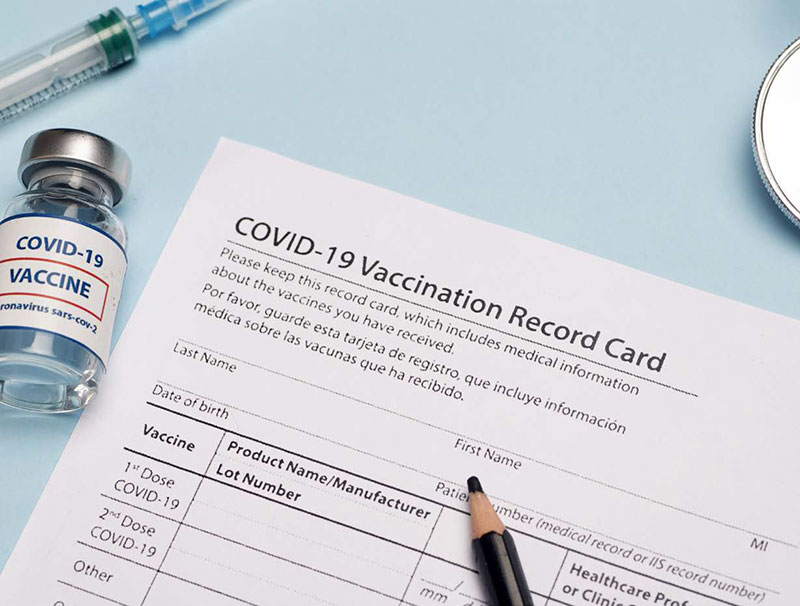
November 2021
Alston & Bird LLP and Aflac
Important note: On Jan. 13, 2022, the U.S. Supreme Court issued an order to stop implementation of the Emergency Temporary Standard for Employee Vaccination Requirements. Following that decision, OSHA formally withdrew the ETS effective Jan. 26, 2022. As a result, employers are not required to comply. However OSHA allowed the ETS to remain in place as a notice of proposed rulemaking subject to public comment. This means that OSHA may attempt to issue additional rules in the future regarding COVID-19 vaccines in the workplace.
Overview
On November 5, 2021, the U.S. Occupational Safety and Health Administration (OSHA) published an emergency temporary standard (ETS) that requires employers with 100 or more employees to establish COVID-19 vaccination requirements for their employees, including implementation of a manda tory vaccination or weekly testing policy.
Claiming the credit.
As you may have seen in the news, the ETS is being challenged in multiple lawsuits across the country. In one of those lawsuits, the United States Court of Appeals for the Fifth Circuit stayed implementation of the ETS on November 12, 2021. As a result, OSHA has suspended activities related to the implementation and enforcement of the ETS pending future developments in the litigation.
On November 16, 2021, the cases challenging the ETS were consolidated and transferred to the United States Court of Appeals for the Sixth Circuit. On November 22, 2021, the U.S. Department of Labor filed a motion asking the Sixth Circuit to lift the stay issued by the Fifth Circuit or, in the alternative, modify the stay to allow for the masking-and-testing requirement to remain in effect.
The OSHA workplace vaccination or testing requirement is currently on hold as the issue is decided by the courts. It’s difficult to predict the ultimate outcome. Nevertheless, employers should be prepared to implement the requirements in case they survive the court challenges.

SECTION 1
Employers and employees covered by the requirements
Which employers are covered by the ETS?
All employers with a total of 100 or more employees are required to follow the ETS except in workplaces that are already covered by the stricter requirements for federal contractors and subcontractors or that are subject to OSHA’s June 2021 health care emergency temporary standard.
The count of employees must be done at the employer level (firm- or corporate-wide), not the individual location level. For example, for a single corporate entity with multiple locations, all employees at all locations are counted. Parttime employees and employees who are working from home count toward the total number of employees. However, independent contractors are not counted.
The ETS commentary and FAQs provide additional guidance on calculating the employee threshold in a variety of contexts, including:
Which employees are required to follow the ETS?
All individuals employed by a covered employer are subject to the requirements of the ETS. However, the ETS does not apply to employees who report to a workplace where others (e.g., coworkers or customers) are not present, employees while they are working from home, or employees who work exclusively outdoors.
Are covered employers required to follow the ETS in states or localities that have laws prohibiting employee vaccination mandates?
Yes. The ETS preempts states and political subdivisions of states from adopting and enforcing workplace requirements relating to the occupational safety and health issues of vaccination, wearing face coverings and testing for COVID-19, except under the authority of a federally approved state plan. OSHA has stated that it intends for the ETS to preempt and invalidate any state or local requirements that ban or limit an employer’s authority to require COVID-19 vaccination, face covering or COVID-19 testing.
How long will the ETS be in effect?
OSHA anticipates that the ETS will be in effect for six months: from November 5, 2021 through May 5, 2022. However, OSHA will continue to monitor trends for COVID-19 infections and deaths and will update the ETS as appropriate.

SECTION 2
Vaccination requirements
What does the ETS require for employee vaccination?
The ETS requires that covered employers must establish, implement and enforce a written mandatory vaccination policy that requires all employees (including all new employees as soon as practicable) to be fully vaccinated, other than those employees: (1) for whom a vaccine is medically contraindicated; (2) for whom medical necessity requires a delay in vaccination; or (3) who are legally entitled to a reasonable accommodation under federal civil rights laws because they have a disability or sincerely held religious beliefs, practices or observances that conflict with the vaccination requirements.
However, the ETS also permits covered employers, as an alternative to a mandatory vaccination policy, to establish, implement and enforce a policy allowing employees to choose between full vaccination and proof of weekly COVID-19 testing, plus wearing a face covering in the workplace.
What does “fully vaccinated” mean, and what types of COVID-19 vaccines are sufficient for the ETS?
Under the ETS, “fully vaccinated” means two weeks after completing a government-approved or authorized primary COVID-19 vaccination series, with the minimum recommended intervals between doses.
Does the ETS require booster shots of COVID-19 vaccines?
No. Booster shots and additional doses are not included in the definition of “fully vaccinated” under the ETS.
Do covered employers have to provide paid leave to assist employees in getting vaccinated?
Yes. Covered employers must provide a reasonable amount of time to each employee to obtain each of their primary vaccination doses and up to four hours of paid time, including travel time, at the employee’s regular rate of pay to do so. In addition, covered employers must provide reasonable time and paid sick leave for each employee to recover from side effects experienced following any primary vaccination dose.
What type of proof of vaccination status is required?
Covered employers are required by the ETS to determine the vaccination status of each of their employees – i.e., whether they are fully or partially vaccinated or not vaccinated at all – and to require each vaccinated employee to provide acceptable proof of vaccination status. Acceptable proof of vaccination status is one of the following:
In instances where a fully vaccinated employee is unable to produce acceptable proof of vaccination, the employer may agree to take as acceptable proof of vaccination a signed and dated statement by the employee that includes an attestation of vaccination status and that the employee has lost or is otherwise unable to produce proof of vaccination status, as well as certain declaration language listed in the ETS.
Must reasonable accommodations be considered if an employee cannot be vaccinated because of a disability or a sincerely held religious belief?
Yes. If an employer mandates vaccinations for employees and an employee cannot be vaccinated because of a disability, as defined by the Americans with Disabilities Act (ADA), or a sincerely held religious belief, practice or observance, the employee may be entitled to a reasonable accommodation under the ADA, Title VII of the Civil Rights Act of 1964, or applicable state law.
What records must employers maintain of employee vaccination status?
Covered employers must maintain a roster of each employee’s vaccination status and must preserve acceptable proof of vaccination for each employee who is fully or partially vaccinated. Because the roster and records are considered to be employee medical records, they must be maintained as such in accordance with OSHA’s requirements for employee exposure and medical records, kept separate from personnel records, and must not be disclosed except as required or authorized by the ETS or other federal law, including the ADA. The records and roster, however, must only be maintained and preserved while the ETS is in effect and are not subject to the much longer retention requirements – i.e., duration of employment plus 30 years – applicable to other types of medical records under OSHA regulations.
When must employers implement a written mandatory vaccination policy?
The ETS provides that employers must implement a written mandatory vaccination policy by December 5, 2021. However, the current stay issued by the Fifth Circuit impacts this date and other relevant dates. As currently drafted, the ETS provides that employees have until January 4, 2022 to be fully vaccinated. If employers decide to permit testing for unvaccinated workers, the requirement to test begins on January 4, 2022.

SECTION 3
Testing requirements
Are employees who are not fully vaccinated required to test?
Yes. Employees who report to a workplace where other individuals (e.g., coworkers, customers) are present must be tested at least once every seven days and must provide documentation of the most recent COVID-19 test result to the employer no later than the seventh day following the date on which the employee last provided a test result. Employees who do not report to a workplace during a period of seven or more days must be tested within seven days of reporting to the workplace and must provide documentation of that test result to the employer upon return to the workplace. If an employee does not produce a COVID-19 test result or tests positive, the employee is not permitted in the workplace.
What kinds of tests are permitted?
A valid COVID-19 test under the ETS is one that is (1) cleared, approved or authorized, including in an emergency use authorization (EUA) by the FDA, to detect current infection with the Sars-CoV-2 virus (e.g., a viral test); (2) administered in accordance with the authorized instructions; and (3) not self-administered or self-read unless observed by the employer or an authorized telehealth proctor.
Acceptable tests include tests with specimens that are processed by a laboratory, proctored over-the-counter tests, point-of-care tests and tests whose specimen collection and processing is either done or observed by the employer.
Who pays for the tests?
The ETS does not require the employer to pay for any costs associated with testing; however, employer payment for testing may be required by other laws, regulations or collective bargaining agreements or other collectively negotiated agreements.
Is the cost of COVID-19 testing (including at-home testing) required to be covered by the employer’s group health plan?
Neither the ETS nor other federal law requires a group health plan to cover testing conducted to screen for general workplace health and safety, public health surveillance or for any other purpose not primarily intended for individualized diagnosis or treatment of COVID-19. Federal law only requires group health plans to cover COVID-19 testing when such testing is medically appropriate for the individual, as determined by the individual’s attending health care provider. Employers may voluntarily pay for such tests; however, they should consider whether such payment creates a group health plan subject to other federal laws (such as the Employee Retirement Income Security Act). Employers that wish to cover such tests through their group health plan should consult first with their insurance carrier or administrators. Employers that are considering providing or covering COVID-19 tests through their group health plan for OSHA compliance, work safety or public health reasons should also consider HIPAA’s broad reach. While in most cases the HIPAA Privacy Rule does not apply to employers and does not protect employment records (even if the information in those records is health related), HIPAA does apply to most health plans and to health care providers who engage in certain transactions electronically. If HIPAA applies to a COVID-19 testing arrangement, then the HIPAA Privacy Rule, Security Rule and Breach Notification Rule all should be considered.
If an employee tests positive, are they still required to test?
When an employee has tested positive for COVID-19, the employer must not require COVID-19 testing for that employee for 90 days following the date of their positive test or diagnosis.
What does an employer do with the test results provided by employees?
Covered employers must maintain a record of each test result provided by each employee or obtained during tests conducted by the employer. These records are considered to be employee medical records and must be maintained as such in accordance with OSHA’s requirements for employee exposure and medical records and must not be disclosed except as required or authorized by the ETS or other federal law.

Can an unvaccinated employee still come to the workplace if they did not obtain a COVID-19 test, but wear a face covering and are isolated while on-site?
No. If an employee who is not fully vaccinated does not provide the result of a negative COVID-19 test, the employer cannot allow the employee to come to the workplace until the employee provides the result of a timely negative COVID-19 test.
If an employer allows for testing as an alternative to vaccination or as an accommodation from a vaccination mandate, must reasonable accommodations be considered if an employee cannot be tested because of a disability or a sincerely held religious belief?
Yes. While the ETS requires weekly COVID-19 testing of all unvaccinated employees, including those entitled to a reasonable accommodation from vaccination requirements, if testing for COVID-19 conflicts with a worker’s sincerely held religious belief, practice or observance, or is medically contraindicated because of a disability, the worker may be entitled to a reasonable accommodation from the testing requirement, which might include using an alternative test that does not conflict with the worker’s religious belief.
When do testing requirements go into effect?
Testing requirements are effective January 4, 2022. However, the current stay issued by the Fifth Circuit impacts this date and other dates mentioned here. Employees who completed the entire primary vaccination series by that date do not have to be tested, even if they have not yet completed the two week waiting period.

SECTION 4
Masking requirements
What does the ETS require for employee face coverings?
Covered employers must ensure that each employee who is not fully vaccinated wears a face covering when indoors and when occupying a vehicle with another person for work purposes, except in limited circumstances. These exceptions include:
What types of face coverings are acceptable?
The ETS requires that face coverings: (1) completely cover the nose and mouth; (2) be made with two or more layers of a breathable fabric that is tightly woven (i.e., fabrics that do not let light pass through when held up to a light source); (3) be secured to the head with ties, ear loops or elastic bands that go behind the head (gaiters should have two layers of fabric or be folded to make two layers); (4) fit snugly over the nose, mouth and chin with no large gaps on the outside of the face; and (5) are a solid piece of material without slits, exhalation valves, visible holes, punctures or other openings. The ETS permits the use of face masks or respirators in lieu of face coverings. A face mask is a surgical, medical-procedure, dental or isolation mask that is FDA-cleared, authorized by an FDA EUA authority or offered or distributed as described in an FDA enforcement policy. Common types of respirators include filtering facepiece respirators (e.g., N95), elastomeric respirators and powered air purifying respirators.
Who pays for costs associated with face coverings?
The ETS does not require the employer to pay for any costs associated with face coverni gs; however, employer payment for face coverings may be required by other laws, regulations, collective bargaining agreements or other collectively negotiated agreements.
When do masking requirements go into effect?
Masking requirements are effective December 5, 2021. However, the current stay issued by the Fifth Circuit impacts this date and other dates mentioned in this article.

SECTION 5
Notification, reporting and records
Are employees required to notify employers when they receive a positive COVID-19 test or are diagnosed with COVID-19?
Yes. Regardless of COVID-19 vaccination status or any COVID-19 testing, covered employers must: (1) require each employee to promptly notify the employer when they have received a positive COVID-19 test or are diagnosed with COVID-19; and (2) immediately remove the employee from the workplace.
The employee may not return to the workplace until the employee:
Are employers required to pay employees following removal from the workplace due to a positive test?
The ETS does not require employers to provide paid time to any employee for removal as the result of a positive COVID-19 test or diagnosis of COVID-19; however, paid time may be required by other laws, regulations, or collective bargaining agreements or other collectively negotiated agreements.
Conclusion
The future of the ETS remains on hold as the litigation continues. If the ETS is upheld, employers will need to act quickly to implement the requirements. This article has provided a high-level summary of the ETS. Employers should consult with their own advisers to determine how the ETS applies to them.
The content herein is provided for general informational purposes and is not provided as tax, legal, health or financial advice for any person or for any specific situation. Employers, employees and other individuals should consult their own advisers about their situations. Aflac herein means Aflac and Aflac New York.
Aflac | Aflac New York | WWHQ | 1932 Wynnton Road | Columbus, GA 31999
Z2101257R1